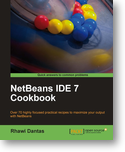It took a long time, but finally here it is. I was asked to review "NetBeans IDE 7 Cookbook" by Rhawi Dantas from Packt Publishing and it took me more time than expected to finish, due to too many other tasks at hand (JavaOne anyone?). First things first - having read through the book I actually think the title is a bit unfortunate, since it suggests content you may not find in there. Reading "Cookbook" in the title I assumed to see "recipes" how to solve problems that the everyday user encounters. But in fact I think it somehow feels more like a tutorial - not that this is a bad thing - I was just thinking about consumers expectations. So, with this book being more of a tutorial, what is the target audience? Well thinking about the stuff I read in there I would suggest it to be a good pick for new or not advanced users. An intermediate user is someone who only knows about parts of the IDE, e.g. SE stuff not EE. If you are using NetBeans in your day job for more than 2 years I would assume you will not find so many new things in there.

So is this book for you? If you are new to NetBeans and want a thorough introduction without reading multiple tutorials, which are available from the NetBeans project homepage, this book may be for you. The tutorials may be more detailed, but I think I like the all-in-one experience of the book. So probably start with "recipes" in the book and if you like what you see dig in deeper using the tutorials from the NetBeans homepage.
You are expecting a rating? Well for new NetBeans users I think it is well above average, for advanced and experienced users it is probably a bit below (depends on your IDE usage patterns I think).
So, what is covered in this book? It is a broad range starting with a quick intro, moving on to the core features of the IDE. One chapter explicitly looks into Matisse, the NetBeans UI design tool. The obligaotry JEE things are in there, as well as a nice primer for how to use JDBC inside NetBeans. The chapter about JavaFX is already outdated, an introduction to mobile development is available. I really like the chapter about refactoring Java code (stay tuned NetBeans users - Jackpot will be back...). What I did not expect after the first few chapters is to have information about extending the IDE (simple but good) and about profiling (although there is more to it than written in the book). Finally there is a good intro into the usage of version control systems with NetBeans (reminder GIT is now available as well).
Anymore to say about the book? ... No, I think this is good - so get the book, if you want to learn NetBeans!

 from Oracle which really gave no real new insights, since nobody is allowed to say anything at all. But just in case - a subset of the slides is available
from Oracle which really gave no real new insights, since nobody is allowed to say anything at all. But just in case - a subset of the slides is available 
